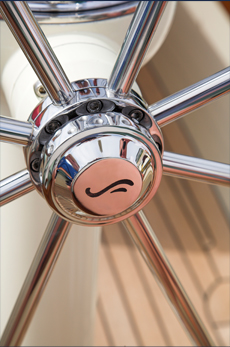About Us

Performance
We have now reviewed five key characteristics of the Friendship 40 that help ensure good performance. There are, of course, many finer points for the designer to consider in balancing speed with comfort, safety, and affordability. There are also many more details controlled by the builder, such as lightweight construction materials, that have an effect on performance.
We have talked so far about “performance” strictly in terms of speed potential, which is primarily to what most sailors relate. From Ted Fontaine’s years of experience in designing all types of yachts, he has developed what we feel is a much more practical definition of “performance.” We define performance as a product of Speed, Comfort, Payload, Range, Safety and Integrity.
The hull design characteristics that we outlined previously have a strong impact on the general use and safety of the complete boat. For example, the typical shoal draft of each Fontaine design allows the owner to visit cruising grounds inaccessible by most boats of the same size; in fact, this ability is as much a motivation for (as opposed to a by-product of ) the Fontaine design concept. A desire by many owners for even less draft inspired the “Delta form” hull form. A reduction in draft of only one foot can open up a whole new world for the cruising sailor to explore, whether it be the Caribbean, Europe, the Chesapeake Bay, Vineyard Sound or the approach to Nantucket.
After looking at how relatively greater beam and displacement contribute to performance via stability and low-wetted surface, let's look at how these features can produce an even greater benefit. First, displacement and beam directly translate into more interior hull volume. This provides substantially more space for interior accommodations and the long list of machinery and equipment required to be comfortable onboard. Substantial water and fuel tankage can all be below floor level so that all space under seats and berths is reserved for storage.
This additional joinerwork, equipment and tankage is extra weight that the buoyant hull is designed to carry without affecting the overall performance. The increase in cruising range and self-sufficiency is of great value.
Second, the heavier displacement hull will have a much easier motion in heavy seas. This feature is instrumental in the owner’s ability to continue sailing at his mature age. A light, flatter bottom hull tends to pound into seas with a quick, uncomfortable motion in large waves. The rounded V-sections of Fontaine designs allow it to push through large seas without acute motion.
Third, and most important to the owners of Friendship 40’s, is the “inertia,” or mass of ballast. A large interior volume and a tall rig have been proven to improve the roll characteristics and increase the capsize resistance as compared to a lighter boat. These characteristics have been documented in a study completed after the 1979 Fastnet Race disaster. In theory, a lighter boat can be rolled over with less resistance, while a heavier boat rolls slower and has time to recover between waves.
Of course, a large part of an owner's comfort and safety is dependent on how easily the yacht can be operated. Fontaine devoted considerable time to the Friendship’s deck layout so that one or two people can operate all systems without leaving the helm. Comfort also includes many other important variables, such as adequate light and ventilation, “real” size berths and a multitude of fine design details that are carefully checked for proper ergonomics. Indeed, we spend many hours refining the interior and deck layouts of each boat to make the absolute best use of a given volume and provide access to all possible storage areas.
The Fontaine design philosophy of a relatively heavy displacement, wide, shoal-draft, centerboard hull is not new. The concept has evolved over time since Fontaine designed his first boat with Ted Hood in 1979.
Ted designed the Friendship 40 to provide a unique balance between pure beauty, speed and other important variables such as “payload,” the ability to carry more interior volume and creature comforts. The old clipper ships of the 1800's were designed much the same way in an effort to move as much cargo as possible, yet still arrive in port ahead of the competition. Interestingly enough, the basic hull shapes of those great ships have remarkable similarities to our current hull designs, although they performed poorly upwind because of their square rigs, narrow hulls and lack of underwater appendages.
A yacht’s displacement is not just its weight on a scale. Archimedes taught us long ago that it is also a measurement of the volume of water displaced which in turn translates into interior volume.
We strongly believe that the most important role for an owner in any design project is to communicate his or her desires, lifestyle and intended use to the designer in the beginning to ensure ultimate satisfaction with the finished yacht. Too often, the design of a yacht is centered around a particular function that may be used only a very small percentage of the time, yet significantly compromises the entire yacht during other times. As a designer, Ted’s goal is to see that an owner’s desires and priorities are identified and properly addressed in the finished yacht.
Ted fully recognizes that his designs are not for everyone. For those with a primary focus on speed, such as deep water racers, there are certainly alternatives. However, we feel that our “performance equation” best exemplifies our balanced approach to yacht design.
The Fontaine Design Group is proud of the variety of boats designed and built throughout the world. The owners of many of these yachts have distinguished themselves on the racecourse or cruised remote areas of the world in great comfort and safety.
